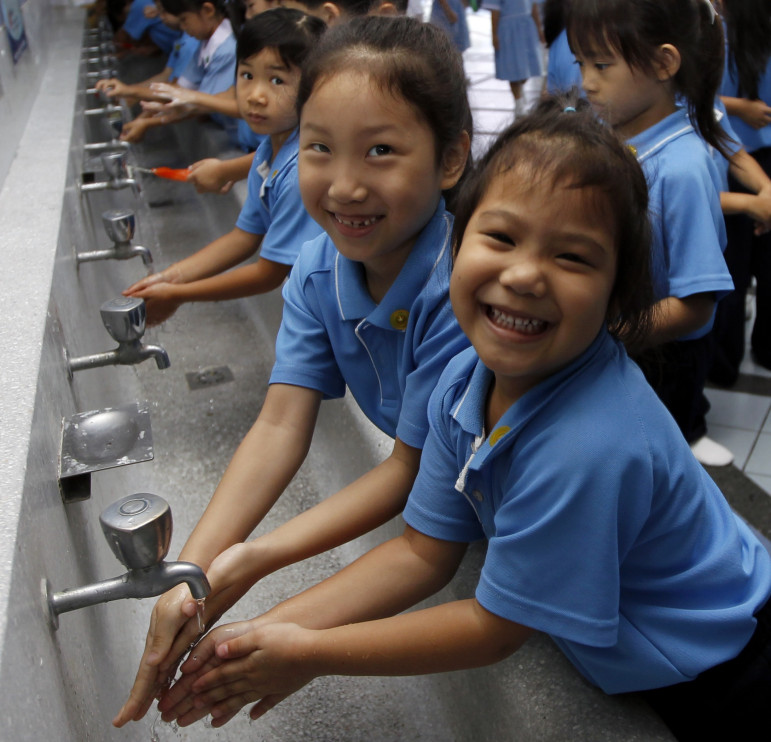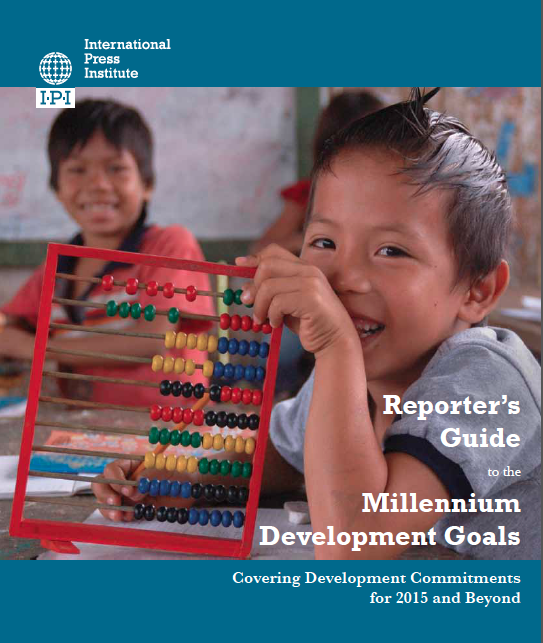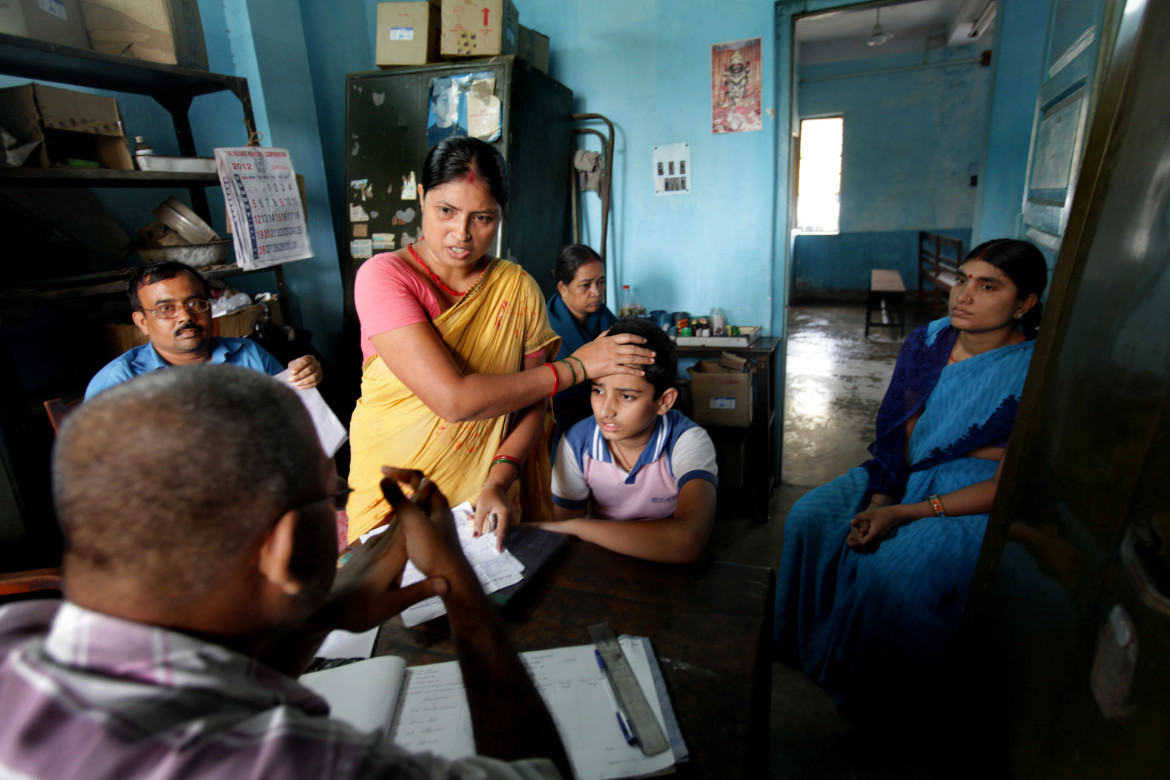

A Dose of Advice: Tips on Covering Healthcare
 Part 11 of a series GIJN is excerpting from the Reporter’s Guide to the Millennium Development Goals: Covering Development Commitments for 2015 and Beyond, published by the International Press Institute.
Part 11 of a series GIJN is excerpting from the Reporter’s Guide to the Millennium Development Goals: Covering Development Commitments for 2015 and Beyond, published by the International Press Institute.

foot and mouth disease control campaign at a primary school in Bangkok, Thailand in July 2012. EPA/Rungroj.
In his 1999 book Development as Freedom, renowned economist and Noble laureate Amartya Sen stated that investment in healthcare can lead to success in meeting a wide range of development targets, such as those identified by the Millennium Development Goals (MDGs).
Indeed, good healthcare improves quality of life, reduces morbidity and mortality, and raises economic productivity. As such, the World Health Organization (WHO) has recognised the importance of universal health coverage (UHC) and urged its member states to adopt programs providing essential health packages.
In general, UHC has the following components: appropriate levels of financing; access to medicines, vaccines and technology; adequate trained personnel; and emphasis on social determinants of health, including income and gender. Critically, media coverage of healthcare topics can help drive support for UHC in all development contexts.
However, in order to advance key development goals, journalists covering healthcare must address not just the symptoms resulting from a lack of adequate health programs and facilities—that is, the problems that emerge when medical treatment is needed—but also the fundamental causes of disease.
Reporting on Health: What To Look For
Good reporting on healthcare means staying constantly aware of events or findings that could have significant health-related consequences, and, thus, that could serve as a starting point for a story. Look out for occasions such as Diabetes Day, Heart Health Day, and so on, as these can be useful opportunities to devote attention to lifestyle diseases, in particular. By staying alert, journalists should be able to spot a range of incidents. Some examples include:
- The reported outbreak of disease, such as cholera or dengue fever, or any collection of unidentifiable symptoms affecting a large number of people;
- A major scientific finding or research development, for example, new knowledge about the effects of climate change on disease, or the challenges of drug resistance. Only recently, for instance, international media has covered extensively drug-resistant tuberculosis (XDR-TB) in India;
- The release of detailed health indicators for a particular region or country from a credible source, such as a census, intergovernmental body, or international fact-finding team;
- A major industrial or natural disaster, such as the earthquake and tsunami that led to the Fukushima nuclear crisis, is bound to have health consequences.
Framing Your Story
Important top-level objectives, such as the MDGs, can appear distant and complicated to citizens and national policymakers; therefore, journalists covering healthcare must work to properly frame their stories within the reality of a particular country or society.
In order to provide the right context for their readers, journalists need to begin their investigation on a particular health issue by asking some basic questions. Imagine, for example, that the plan is to cover the challenge of under-five mortality, which refers to children who do not survive until their fifth birthday. There are some elements that should be included in such a report:
- Statistics: mention the current under-five mortality rate in the specified area.
- Changes: analyze the pattern of under-five mortality over the past decade, or earlier.
- Policy efforts: refer to any significant government-initiated initiatives aimed at reducing the mortality rate, whether successful or not.
- Transparency and reliability: evaluate the reliability of the data on mortality (consider the type of health information system the country has in place, or the lack of such a system).
From here, there are many angles that journalists could explore in a story on under-five mortality. Maybe, one good place to begin is with any potential asymmetries in healthcare related to geography, economic status, gender, or other social determinants. Do certain regions—ranging from states and provinces to individual cities and villages—have higher death rates for children under five? Are poor children or girls at a greater risk of death? If yes, why?
Journalists working in countries with unique, long-established social traditions, such as those in South Asia and Africa, should keep in mind that health-related goals often depend on reporting across cultural barriers. Consider, for example, a rural village that the medical community has identified as exhibiting a high rate of child mortality. An investigation should look at which cultural factors, including community and family hierarchies, affect children’s chances of survival.
Working backwards, a journalist could also examine the effect of existing policy interventions. There is research data, for example, demonstrating a positive correlation between public spending on skilled delivery assistance and immunization for the poor, and reduced child mortality. Compare and contrast, also, policy initiatives among various countries as an example of what has worked and what has not.
For economies that rely heavily on donor aid to fund health system initiatives, tracking the flow of aid is a key coverage point. Journalists should analytically evaluate implementation data and the credibility of reporting mechanisms to investigate whether aid is reaching its intended target.
In the context of developing countries, covering the flow of aid also includes monitoring the efficacy of specific initiatives, such as the distribution of insecticide-treated bed nets to protect against malaria in young children. Look into the outcome and ask the basic but powerful question: Is the initiative working? Talk to parties on both sides: Do the expectations of donors match the experiences of the recipient communities?
Remember that while the above suggestions and categories refer specifically to under-five mortality, they are applicable to writing stories on any health-related topic.
Where To Find Information and Sources

L) checks patients at a malaria and dengue clinic in Calcutta, India, Sept. 2012. EPA/Piyal Adhikary.
No matter the tack you choose to take, it will be critical to identify key sources, cross-check information with public health authorities wherever warranted, and obtain views from all those involved before drawing any inferences or note any caveats.
However, while authentic data is needed to arrive at an informed conclusion, it is certainly not always easy find. Below are some key suggestions of places where investigative journalists can seek information on healthcare.
The WHO is the primary source of data used in most international policy discussions. Vital indicators relevant to the MDGs, including poverty, life expectancy, fertility, mortality, prevalence and incidence of communicable diseases, and access to pharmaceuticals are reported periodically by the WHO, which often synthesizes data from multiple reliable channels, such as UNICEF, the UN Population Fund, and the World Bank.
There are also many peer-reviewed journals dealing with public health issues, MDGs, and clinical research. These include The Lancet, the British Medical Journal, The Journal of the American Medical Association, and Science. In addition to “open access” journals, which provide scholarly material free of charge, a number of subscription-based scientific publications grant free access to journalists who make a formal request. If not, note that authors are usually happy to provide reporters with the full text of a specific article in question if contacted directly.
Some governments, including those in emerging economies, may seek to obscure healthcare data in order to avoid political opposition and electoral losses. But, in countries where national freedom of information laws exist, journalists are within their rights to make public certain information and data not proactively published by authorities.
Answers given by ministers during legislative hearings also often provide valuable information. Look for parliamentary committee reports, which some countries, occasionally, make public on the Internet. In many cases, research groups and activists analyse such reports and share them with journalists.
NGOs and private foundations without commercial interests and not affiliated with a political party provide valuable information to journalists. One example is that of the Commonwealth Fund in the United States, which compared the likely impact of health policies of the two major contenders in the 2012 presidential elections.
Focus on Healthcare Infrastructure
Any story on healthcare will have to examine and take into account the healthcare system currently in place.
Consider these questions:
- How do individuals pay for healthcare? Is there financial support from official agencies?
- Is there a cashless provision at the point of care?
- Is there a national list of “essential medicines” that matches or builds on the recommendations of the WHO? Are these medicines subject to price control?
- Is there infrastructure in place to test the quality of medicines both produced in the country or imported?
Don’t forget that the credibility of health data can itself be the subject of news coverage. If the public health system of a region or country does not have reliable, publicly available data on the health of children, women, and persons diagnosed with infectious diseases, such as HIV/AIDS, malaria and tuberculosis, that, in itself, is a story worth telling.
Remember that the inability to pay for medicines, diagnostic testing, and/or hospital admissions is a major cause of distress and impoverishment in many countries. If available, health expenditure data can indicate the level of out-of-pocket spending by citizens, in the absence of government support of insurance schemes.
Lifestyle Diseases
Finally, a growing area of concern is the emergence of lifestyle diseases. These ailments are linked to social factors that influence individual behaviour—such as promotion of tobacco and alcohol, poor awareness of unhealthful food, and high levels of stress.
Interestingly, even some emerging economies face health consequences due to a nutrition paradox: excess nutrition and lack of physical exercise in one sector of the population, and lack of nutrition and food security in another. This requires sensitive coverage of both dimensions, which may indicate further problems, such as poor income redistribution, and the influence of special interests.
The media can help correct such an imbalance by asking the right questions:
- Is subsidized food in public distribution systems unhealthful?
- Are food stamps, vouchers, or cash transfers encouraging poor habits?
- Is there adequate visibility for campaigns on the ill-effects of lifestyle choices?
As the window to the world for most of the public, the media has a responsibility to ask and answer questions like these that will enlighten the public and further enable the success of national and international healthcare initiatives such as the MDGs—which, in turn, increase quality of life and economic productivity.
——————–
 G. Ananthakrishnan is associate editor at The Hindu, where he writes on public health, the environment, and welfare. He was previously the paper’s city editor and internet editor.
G. Ananthakrishnan is associate editor at The Hindu, where he writes on public health, the environment, and welfare. He was previously the paper’s city editor and internet editor.
Excerpted from Reporter’s Guide to the Millennium Development Goals: Covering Development Commitments for 2015 and Beyond. Agreed to in 2000, the UN Millennium Goals comprise an ambitious agenda to improve quality of life around the world, focusing on such issues as poverty, gender equality, and education. This unique manual, available in four languages, offers journalists practical tips on covering these critical areas as we near the 15th anniversary of the goals. Twenty-one journalists across six continents contributed to the report, including several active in GIJN. We are grateful to the publisher, the International Press Institute, for permission to publish the series, and to the European Press Photo Agency and EFE Agency for permission to publish the accompanying photos.









